Tōkyō Street Markings and Scenery
Streets are an important part of the scenery of a city, and are rich in detail, with signs, electrical and other poles and wires, manholes, drains, markings, guardrails and sidewalks.
All of these are an unobtrusive yet strong reminder that “we aren’t in Kansas anymore”. While street markings in Tōkyō are similar to American ones, and many are easy to understand even if unfamiliar, they are distinctly different.
Note: while Tōkyō actually consists of a number of largely-independent cities (the 23 “special wards”), and details of signage or markings could vary, there seem to be a large number of common features regardless of location.
Intersections
Below is a fairly typical side-street scene, in the Setagaya ward of Tōkyō. The near street is two-way (the stop line does not fill the end of the street). The opposite street is a one-way street (the stop line does fill the width, and the “do not enter” sign above the intersection makes it plain). The lack of a separate sidewalk, and the use of white lines to denote the edges of the road (typically not present on roads with real sidewalks) are characteristics of smaller streets. Also note the design of the crosswalks (a set of bars without lines at the edge; some crosswalks do have lines at the edges, but this style is more common). The concrete channels on the side are also common, and likely serve to channel Tōkyō’s substantial rainfall to storm drains. Note the use of metal poles for power lines, and the mirror to allow drivers to see traffic to the side.
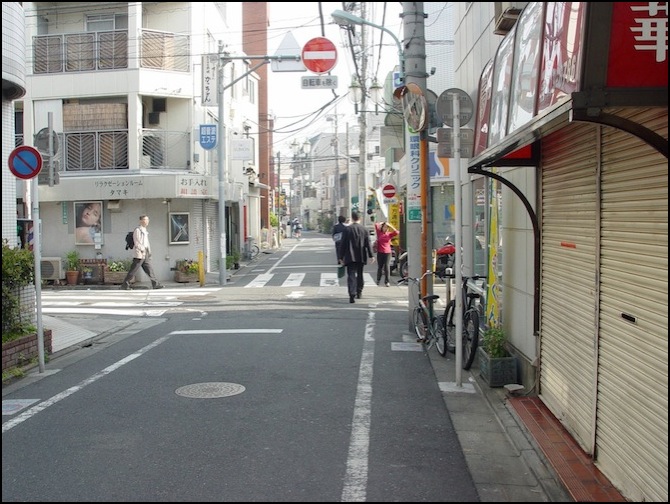
Street near Ikenoue Station, Inokashira Line, Mitaka, Tōkyō
Photographer: っ
The following picture from the Taito ward of Tōkyō shows a typical small intersection, although apparently one with no stop lines before the crosswalks and no edge-of-street lines. The raised curb probably accounts for the lack of edge lines. Also note how the edge of the curb is at street level at the corners, but raised elsewhere, and how the yellow warning texture is apparently applied in lines facing each crosswalk. Also, the white guardrail between the sidewalk and the street (just visible at left, and possibly in the distant right) is fairly common, but not universal.
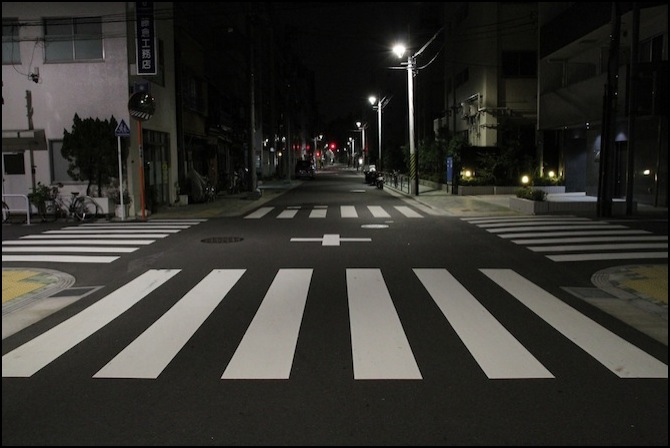
Intersection in Asakusabashi, Tōkyō, Japan
Photographer: OiMax
This is a more substantial avenue, from Fuchū City, Tōkyō, showing the solid yellow centerline common to larger bidirectional streets. The yellow “30” printed on the street is the speed limit, matching the sign to the left. Although median strips with vegetation are not uncommon on larger avenues, this one is exceptional, and is a “national natural monument” according to a caption on a similar photo. Note that the white edge lines, and the crosswalk, are both similar to the smaller city street seen above.
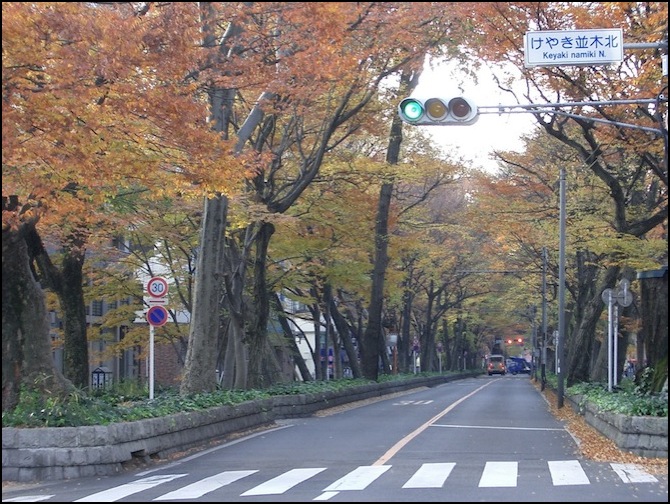
Keyaki Namiki N, Fuchu, Tōkyō
Photographer: excel-zoo
Lane Markings
Below is a busy street in Ginza, in the Chūō ward of Tōkyō, also known as Chūō City, showing a different central divider, and several forms of lane marking (the “8-20” is a “no U-turn 8 AM to 8 PM” indication for the upcoming intersection). Note the yellow paint on the curb (to indicate “no parking”, I think).
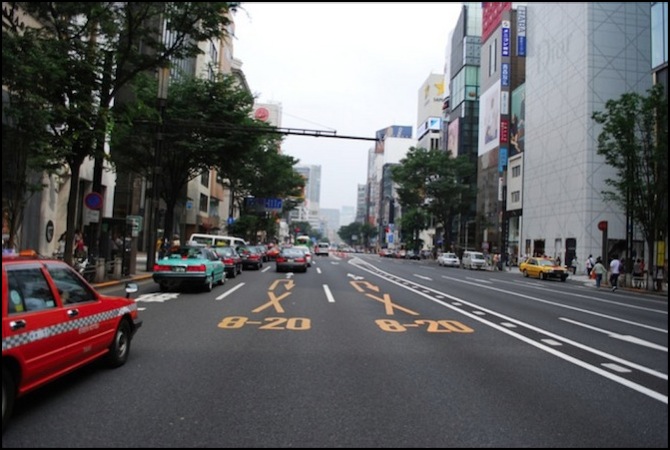
Street Markings in Ginza, Tōkyō
Photographer: sortulv
On the left, a marking adjacent to a crosswalk for bicycles (is it a separate stop line, or a warning to drivers that bicycles may be present? I don’t know), and some other pictures giving a closer look at directional markings (found leading into an intersection on major roads, to indicate “turn” or “straight-only” lanes). The final photograph shows the lettering for “Tomare” (⽌まれ, Stop), which is typically written on a street before a stop line. All of these photos come from Ginza, in the Chūō ward of Tōkyō, except for the last, which is actually from Kandakajicho, Tōkyō.
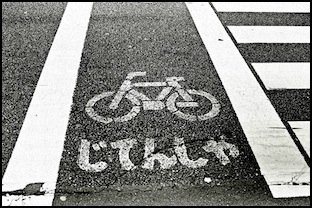
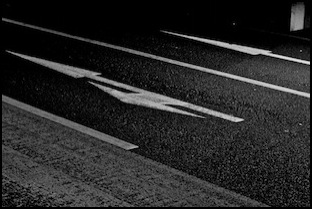
Street Markings for “bicycle only” stop line and turning lanes
Photographer: sinkdd (both)
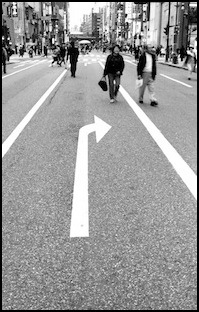
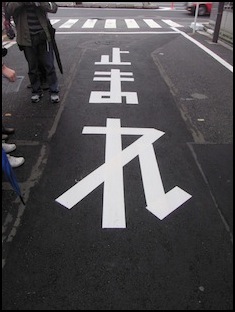
Another Turn Arrow and a “stop” warning
Photographers: mrjorgen and chidorian
Below is an example of a multi-lane intersection, with turning lanes (apparently) highlighted in red, various lane markings (note the curving dotted lines in the interesection), and a median. This photo is also from Ginza.
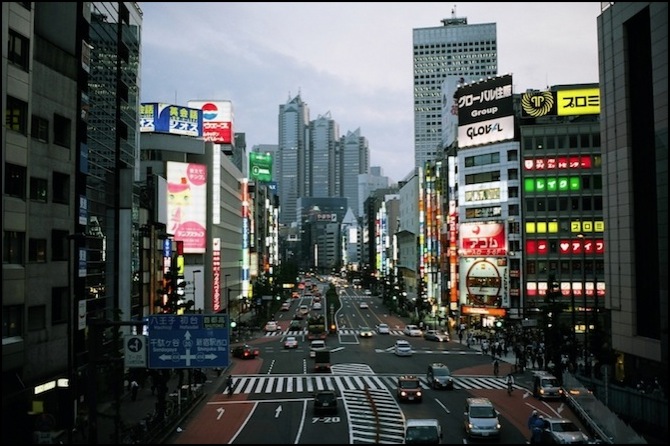
Large Intersection
Photographer: sinkdd
Crosswalks
A sequential pair of diamonds (usually white) is used to warn drivers of upcoming cross-walks. Here (left, below) the diamonds are yellow, with a figure of a running person (perhaps due to excessive traffic or something like a school crossing). Also note that the narrow street has no lines. A different intersection (right, below), shows the use of red-painted pavement on the approach to an intersection (this isn’t used everywhere, and the exact meaning is unclear, but I expect it means “caution”). It also shows a cross in the middle of the intersection, used to indicate traffic entering from all four directions. Finally, note the absence of lines here at the edge of the road, perhaps because of the raised curbing.
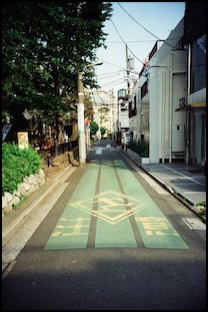
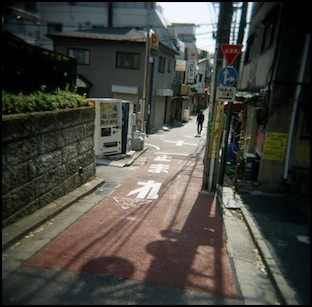
Crosswalk and Caution Markings
Photographer: sinkdd (both)
Here’s the more conventional warning of an upcoming crosswalk (note that the photographer is likely standing on the crosswalk, as this appears to be a one-way street towards the camera. This photo was taken in the Ginza section of Chūō ward in Tōkyō. This photo also shows an example of a large street with raised curbs and no line alongside them, as well as marked parking spaces along one side.
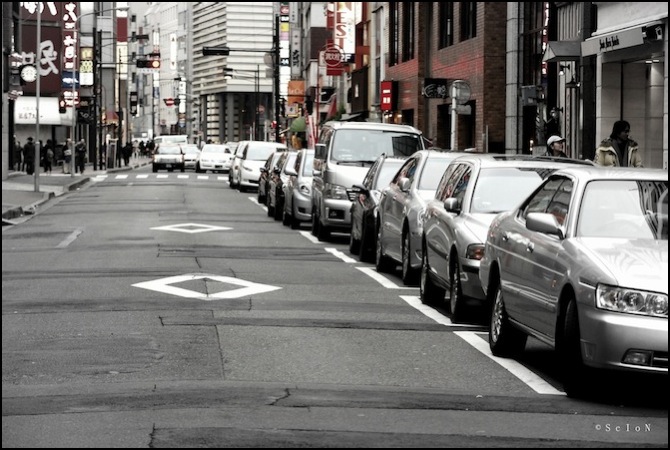
Approach to Crosswalk, Ginza, Tōkyō
Photographer: scion_cho
Back Streets
Although described as an “alley” by the photographer, the presence of a white line implies that vehicle traffic is expected on this very narrow street between a railway embankment and the buildings. Notice how the white line is not painted across the manhole covers (other photos show the same thing on major roads, with even crosswalk lines broken to avoid painting the metal covers). This alley is in the Shibuya ward of Tōkyō.
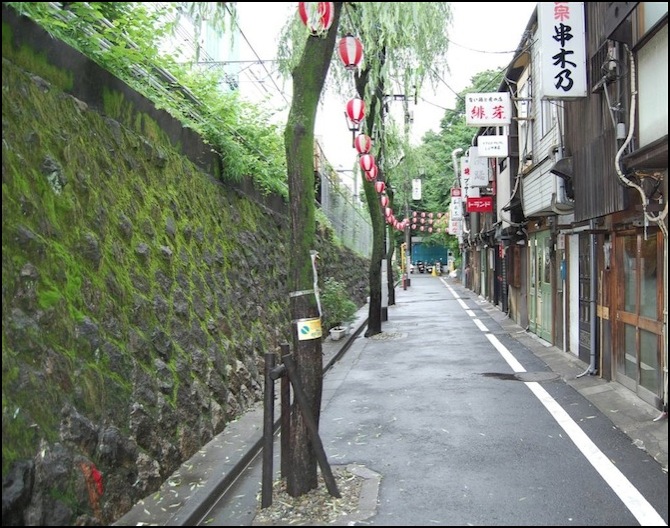
Shibuya Shops
Photographer: wazulawazu
Below is a small street alongside the viaduct for the Yamanote and Keihin-Tōhoku Lines near Okachimachi Station (in Taitō ward, between Ueno and Akihabara stations). Note how the area under the viaduct has been divided into two-storey buildings with shuttered lower sections (storefronts, or garages?) and windowed sections above. On the street, note the white “T” for the side street, and the distant crosswalks and lights, as well as the lack of any curb-side lines on either side.
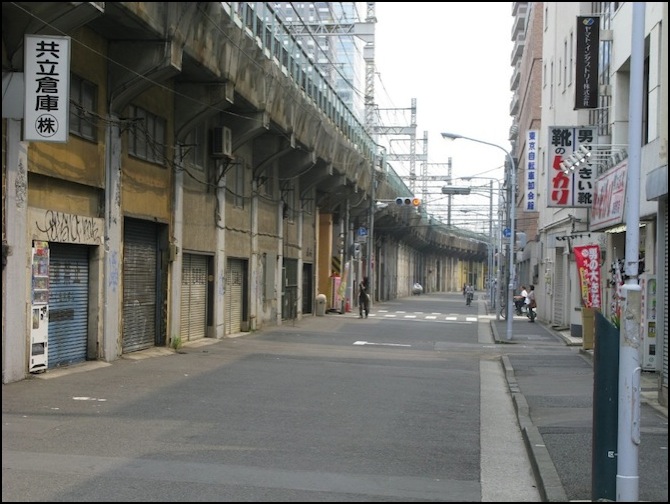
Shops beneath the viaduct
Photographer: Rob Ketcherside




